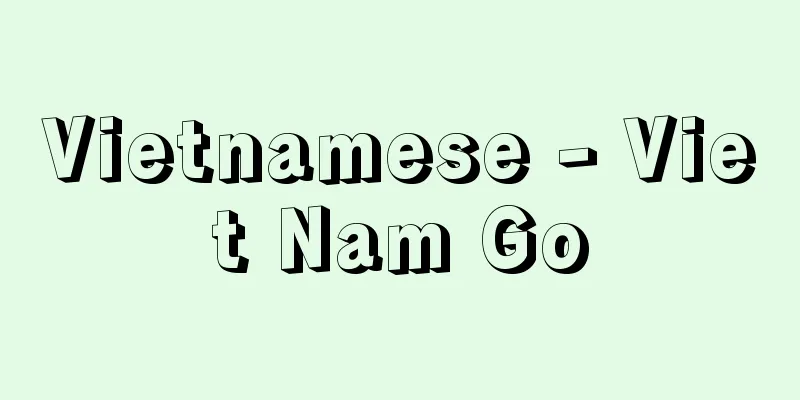Vietnamese - Viet Nam Go

|
The language of the Vietnamese people who live on the east coast of the Indochina Peninsula. It is the national language of the Socialist Republic of Vietnam, spoken by approximately 60 million people. It is also called Etsunango (Vietnam), as "Viet" is the phonetic reading of the Chinese character "Etsunan", and is also called "Viet" in its own words, but it was formerly called Annam or Annamite. It is a monosyllabic, invariant language belonging to the Viet-Muong group of the Mon-Khmer family of Austroasiatic languages, and is a tonal language with six tones. The syllables have a [consonant + vowel + consonant] structure, and phonologically there are 11 vowel phonemes, including two short vowels, and 22 consonant phonemes, but among the consonants, the initial consonants, including the semivowel "watari" that appears before the vowel, are counted as 20, and the final consonants as 11. It is divided into two major dialects, the Northern and Southern dialects and the Central dialect, the former of which is further divided into the Northern and Southern dialects, and in fact three dialects are observed, but since the Vietnamese, who originally lived mainly in the Song Khoi River (Red River) Delta in the north, developed into the Central and Southern regions only after the 16th century, the differences between the other dialects and the normative Northern dialect are not so great. The predicate form has a subject + predicate + object word order, but the fact that modifiers are placed after the word they are modified is considered a grammatical feature, along with the fact that classifiers that capture the nature of things and give a general name are placed before nouns. Other interesting linguistic facts include the distinction between exclusionary forms that do not include the addressee and inclusionary forms that do include the addressee, and the use of kinship terms generally as personal pronouns or appellations, with subtle differences in their use depending on gender, age, and the relative status of the speaker and addressee. Because the Vietnamese have had contact with Chinese culture since ancient times, they have borrowed a great deal of vocabulary from Chinese, and at the level of modern language used in newspapers and other media, about 70% of the vocabulary is in Chinese or Chinese characters, known as Sin-Vietnamese. These words are pronounced in the Vietnamese Chinese phonetic style that was established around the 11th to 12th centuries, following the pronunciation system of Chinese from the Tang Dynasty in China, but in addition to them, Old Sin-Vietnamese borrowed from older Chinese, and Vietnamese-style Sin-Vietnamese borrowed from Chinese after the Tang Dynasty and considered to have become ethnic languages, form the whole vocabulary by supplementing the ethnic language vocabulary. In the societies of successive feudal dynasties, the written language was classical Chinese, read aloud using the sounds of Chinese characters, and Chinese characters were the only official writing system, but the use of the national script Chu Nom, which was invented based on Chinese characters, to write spoken language became popular from around the 13th century and continued until the 19th century. However, the Romanization system invented by Christian missionaries in the 17th century gradually became widespread, and writing using Chinese characters and Chu Nom was abolished in the 20th century, and today the official writing system is the National Language (Quok Ngu), a Romanization system that uses unique auxiliary symbols. [Kunie Kawamoto] [Reference] |Source: Shogakukan Encyclopedia Nipponica About Encyclopedia Nipponica Information | Legend |
|
インドシナ半島東海岸地帯に分布するベトナム民族の言語。ベトナム社会主義共和国の国語で、使用人口は約6000万。「ベトナム」が漢字「越南」の字音読みであるため越南語(えつなんご)ともいい、自称では「越(ベト)」語という言い方もするが、かつては安南語、アンナム語とも称した。オーストロアジア語族モン・クメール系言語のベト=ムオン諸語に属す単音節型不変化語で、6種の声調をもつ音調言語。音節は[子音+母音+子音]構造で、音韻的には2個の短母音を含む11の母音音素と22の子音音素がたてられるが、子音のうち母音の前に現れる「わたり」の半母音を含めた頭子音を20、末子音を11に数える。北部・南部方言と中部方言に二大別され、前者はさらに北部および南部方言に分かれていて、実際には3種の方言が観察されるが、もともと北部のソン・コイ川(紅河)デルタを中心に居住していたベトナム人の中部・南部両地方への発展が16世紀以降であったため、規範とされる北部方言に対して他の方言が示す差異はさほど大きくはない。叙述形式は主語+述語+目的語の語順をとるが、修飾語が被修飾語の後ろに置かれる点が、事物の性状をとらえて汎称(はんしょう)する類別詞を名詞の前に置くことなどとともに文法上の特徴とされる。複数の第一人称代名詞に聞き手を含まない排除形式と聞き手を含む包含形式が区別されることや、親族名称が一般に人称代名詞や呼称詞として使用され、性別や年齢により、また話し手と聞き手の相対的地位を考慮して微妙に使い分けられることも興味ある言語事実である。ベトナム人が古くから中国文化と接触したため中国語からおびただしい語彙(ごい)を借用しており、新聞などで用いられる現代語の水準で70%前後の漢越語とよばれる漢語または漢字語彙が含まれている。これらの語彙は中国唐代の中国語の発音の系統を引いて、11~12世紀ころに成立した越南漢字音で発音されるが、そのほかにも、より古い中国語から借用された古漢越語や唐代以降の中国語から借用されて民族語化したとされる越化漢語などが、民族語の語彙を補う形で語彙の全体を形成している。 歴代封建王朝の社会では、漢字音で音読する漢文が書きことばで、漢字が唯一の公式の文字であったが、漢字を基に考案された民族文字チュノムによる話しことばの表記も13世紀ころから盛んになり19世紀まで行われた。しかし17世紀にキリスト教宣教師によって発明されたローマ字表記法がしだいに普及し、20世紀に入ると漢字とチュノムによる表記は廃止され、現在では独特の補助符号を用いたローマ字体系である国語(クオックグー)を正式の文字としている。 [川本邦衛] [参照項目] |出典 小学館 日本大百科全書(ニッポニカ)日本大百科全書(ニッポニカ)について 情報 | 凡例 |
<<: Vietnamese - Vietnamese (English spelling)
>>: Communist Party of Vietnam (English: Dang Cong San Viet Nam)
Recommend
Underemployment - underemployment
This refers to an employment situation in which t...
Architectural hardware - architectural items
This refers to metal parts used in architecture ot...
Autumn larch - Autumn larch
A large perennial plant of the Ranunculaceae fami...
Kamona - Maybe
...A biennial plant of the Brassicaceae family. I...
Heterotropa aspera (English spelling) Heterotropaaspera
… [Mitsuru Hotta]... *Some of the terminology tha...
Divine Order - Shinkai
Ranks given to gods. Also called shin'i. They...
Dong Yue Temple (English: Dong Yue Temple)
This Taoist temple enshrines the god of Mount Tai,...
Houseboat - Ebune
A group of fishermen who lived a nomadic life, ba...
Uniform random numbers - Ichiyoransu
...Therefore, the sequence of numbers obtained by...
Brick chamber tomb - Senshitsubo
A tomb chamber constructed using bricks when the d...
Kaminoirōgawa River
...A river that flows almost southwest through th...
Abuse of the right to prosecute - kosokenranyo
When a prosecutor abuses his/her power to indict (...
Phase - Yes
[1] 〘 noun 〙① The external appearance from which o...
"Kashiginkou Emaki" - Kashiginkou Emaki
…1 volume. Also known as “Nozarashi Kiko” (Travel...
Pasargadai
…the ruins of the royal capital of the Achaemenid...


![Toya [village] - Toya](/upload/images/67cc52f159018.webp)




![Shirataka [town] - Shirataka](/upload/images/67cbe5681a405.webp)

